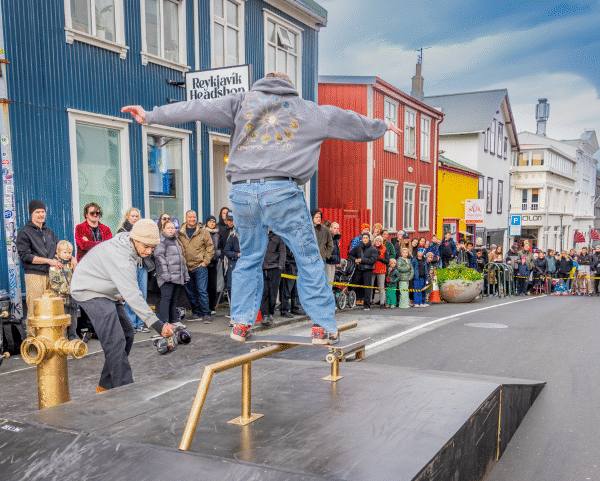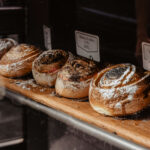Berry picking season in Iceland is magical when the countryside bursts into a riot of colour and flavour. From late summer to early autumn, the wild landscapes are sprinkled with ripe, juicy berries that Icelanders can’t resist hunting for. Thanks to Iceland’s unique climate and geography, various wild berries thrive here, like bilberries, crowberries, and wild strawberries.
This foraging tradition ideally melds with the philosophy of the Slow Food Movement: people sharing a landscape and its resources, sustainably harvesting nature’s bounty at a pace in tune with the land and its natural cadence.
Bilberries: Iceland’s Medicinal Gem

Bilberries (Vaccinium myrtillus) are small, dark berries that grow on a shrub closely related to the blueberry bush. This shrub is distinguished by its lighter branches, finely toothed leaves, and red-green or pinkish-red flowers. The darker and less sweet berries than typical blueberries ripen in late summer across Iceland. They thrive in forests, hollows, and heathlands, often flourishing in areas with heavy snowfall. They are most abundant in the northern regions of Iceland, while less common in the south, though still regularly found. Bilberries are the favourite berry of many Icelanders, and families often have their own special berry picking grounds, which they keep secret.
With a history of medicinal use dating back over a thousand years, British pilots notably used bilberries during World War II to improve night vision, sparking ongoing research into their benefits for eye health. Today, they’re popular as a dietary supplement due to their high antioxidant content, which is believed to boost the immune system, reduce cardiovascular risks, and slow wrinkle formation.
Bilberries have been traditionally used to treat various ailments, including diarrhoea, eye conditions, varicose veins, and sore throats. They are also applied externally for wound healing and other skin conditions. In short, bilberries are a small but powerful natural remedy deeply embedded in Icelandic and European traditions.
Blueberries: Iceland’s Small but Mighty Healer

When fully ripe, blueberries (Vaccinium uliginosum) are dark blue on the outside and greenish on the inside, with colourless but flavourful juices. The blueberry shrubs’ leaves vary in shape and form. The flowers are clustered near the top of the previous year’s shoots. Blueberry shrubs can be found throughout the country, particularly in wetlands and heathlands. The blueberry bush blooms from May to June and typically grows to a height of 10–30 cm.
The timing of berry ripening depends greatly on the weather, but like other Icelandic berries, they generally aren’t fully ripe until after mid-August. The berries, leaves, and roots were considered cooling and astringent. They were used to treat scurvy, fever, and diarrhoea. It was believed that sprinkling powdered root on festering wounds was beneficial.
Blueberries are almost everywhere, and some areas are ripe for berry picking. They’re even in popular tourist spots like Þingvellir National Park.
Wild Strawberries: A Favourite Among Birds

Wild strawberries (Fragaria vesca) are hardy, low-growing plants found throughout Iceland, especially on south-facing, well-vegetated slopes. They can produce a good amount of berries in warm, sheltered areas. The leaves are trifoliate with toothed, silvery undersides, and the white flowers bloom from June through late summer. By late summer, both flowers and ripe berries can be found on the same plant.
The berries are usually small, but those with ample sunlight can grow larger. However, birds often claim them as soon as they ripen. Wild strawberries grow mainly in lowlands, rarely above 350 meters, and spread through runners. They thrive in well-drained, moderately fertile soil and tolerate partial shade, though this can reduce berry production. Native to the Northern Hemisphere, including Iceland, wild strawberries belong to the rose family (Rosaceae).
Crowberries: Iceland’s Arctic Berry

Crowberries are the fruit of a plant known as crowberry bush (Empetrum nigrum), widespread across the Arctic region, primarily north of the 60th parallel. However, this resilient plant also thrives in high-altitude areas further south. Birds easily disperse the seeds of crowberries over long distances, contributing to the plant’s spread across the Arctic.
In Iceland, crowberry bushes are among the most common plants and can be found almost everywhere, especially in exposed, open areas rather than sheltered spots. The crowberry bush has two subspecies. The first, ssp. nigrum, grows only in lowland areas and produces single-sex flowers. The second, ssp. hermaphroditum, is much more common and found both in lowlands and up in the mountains, with hermaphroditic flowers.
Crowberry bushes have been in Iceland for millennia, arriving long before humans settled the country. Pollen from crowberry plants has been discovered in sediments in Geitkarlsvötn, Skagahreppur, dating back around 10,000 years. Crowberries are even more abundant than blueberries, and even if they’re not as popular (by taste) as their blue counterparts, it’s great fun going berry picking crowberries.
Stone Bramble: Great for Jams

Stone bramble (Rubus saxatilis) is commonly found in lowland areas throughout Iceland. It thrives in fertile slopes and hollows, often growing in forest undergrowth. The berries ripen relatively late in the summer and are frequently used in jellies and jams. They grow in tight clusters, with many berries grouped together. While stone bramble typically grows in lowlands, it can also be found at elevations up to 500 meters in suitable conditions.
The fruits are red, glossy drupes, 7-8 mm in diameter, clustered tightly together, each containing a single stone surrounding the seed.
Dwarf Cornel: A Rare Delight

Dwarf Cornel (Cornus suecica), known as skollaber in Icelandic, is a rare plant in Iceland. It is found primarily in the Westfjords, the outer regions of Eyjafjörður, Snæfellsnes, and the northernmost parts of the Eastfjords. It typically grows in heaths, grassy hollows, and low shrubs in snow-heavy areas. Dwarf Cornel usually appears in small patches but can form dense spreads. Most known locations are at low elevations, up to 200 meters, with no confirmed sightings at higher altitudes.
The flower has four stamens with yellowish-white anthers and a single pistil with a dark style, which, if fertilized, develops into a large, bright red drupe (the skollaber). These berries do not ripen until late autumn, often in September, with only 2-3 berries maturing per cluster. The flower stems are covered in white, appressed hairs. The leaves are opposite, ovate or egg-shaped, 1.5-2.5 cm long, pointed at the tip, and have a distinct, curved vein pattern similar to the white bracts.
Juniper: Iceland’s Native Evergreen

Juniper (Juniperus communis) is Iceland’s only native conifer, part of the cypress family (Cupressaceae). Globally, there are around 50-60 juniper species. In Iceland, juniper grows as a shrub with a woody, often ground-hugging trunk. The bark is thin and brown, and the evergreen, needle-like leaves are sharp, measuring 8-16 mm long.
Juniper plants are dioecious, meaning individual plants are either male or female. Only female plants produce berries, but pollination requires a nearby male plant. The berries take three years to mature, starting as green and turning dark blue by the third year.
Icelandic juniper is divided into two subspecies: J. communis ssp. nana, a low-growing shrub with thick, curved needles, and J. communis ssp. communis, an upright form with longer, straighter needles found mainly in western and northern Iceland. Juniper thrives in rocky areas, scrublands, and heathlands, reaching elevations up to 700 meters.
Historically, juniper was valued for its medicinal properties. It is believed to treat ailments like respiratory diseases, tuberculosis, heartburn, and kidney disorders. Modern research confirms its antibacterial and antifungal effects. Juniper berries are also used as a spice, particularly for games and drinks like gin. The plant is common across northern Europe, North America, and southern Greenland, with Icelandic juniper thought to have arrived from Northern Europe after the Ice Age.
Lingonberry: A New Settler

Lingonberry (Vaccinium vitis-idaea) is rare in Iceland but common in Norway and Sweden. It resembles bearberry but has thinner, slightly toothed leaves with rolled edges. The berries are red and juicy, unlike the dry, mealy bearberry berries. In Iceland, lingonberry is found mainly in the Eastfjords and a few locations in Öxarfjörður. Recently, it has also appeared in Þrastarskógur and Rauðavatn, likely due to forestry efforts. All known locations are in lowland areas below 200 meters.
The flowers are small (6-7 mm in diameter), bright red, and drooping, with deeply lobed petals and a dark red calyx. The berries are 5-7 mm in diameter, with the style visible on top. The ground-hugging shoots have sparse, evergreen leaves that are narrow, heart-shaped, and slightly toothed, dark green or reddish above and light green below.
Wild Raspberries in Iceland

Raspberries (Rubus idaeus) were initially planted in people’s yards but easily spread. In Hallormsstaður in East Iceland, raspberries have spread in the forest after two bushes were planted 40 years ago. Hallormsstaður isn’t the only place in Iceland where wild raspberry plants thrive, though their locations are often kept under wraps.
These raspberry plants can be found in forests nationwide, especially beneath birch canopies where the cover isn’t too dense. With the right amount of light and nutrients, they flourish. However, raspberries only produce fruit in their second year, and the plants typically die after five or six years. Weaning through the thicket carefully is important to gather the berries, avoiding the root shoots that sustain the grove. In recent years, some of these groves have expanded significantly, with plants reaching up to two meters in height—making it easy to lose yourself in a raspberry forest. What a delightful way to get lost—berry picking raspberries in the serene birch forests of Iceland!
Black Currant: Popular Garden Berry

In addition to the more common berries mentioned earlier, a few other varieties, like black currants, are also grown in Icelandic gardens. Black currant (Ribes nigrum) is a deciduous shrub from the gooseberry family (Grossulariaceae), native to Northern and Central Europe and Northern Asia. Hardy and easy to grow, black currants have been cultivated in Iceland for many years, though they’ve never quite reached the popularity of red currants (Ribes x pallidum and R. rubrum). Depending on the variety and conditions, these shrubs typically grow to a height of 1-2 meters and spread 80–150 cm. The entire plant is aromatic, especially the leaves and buds when crushed. The leaves are palmate with 3-5 lobes, and the ripe berries are black, clustering together on the branches.
Iceland has tested over forty black currant varieties, with Scandinavian varieties proving the most successful. While black currants can self-pollinate, planting different varieties together ensures better pollination and, consequently, better fruit production. Insects like bumblebees primarily facilitate pollination.
Red Currant: Possibly the Most Popular Garden Berry

Redcurrant (Ribes rubrum), native to Western Europe, has been cultivated since the 17th century, first in Northern France and Belgium. These shrubs typically grow to 1 to 1.5 meters, sometimes reaching up to two meters. The berries are usually bright red, though a light pink variety known as “kirtilrifs” or white currants also exists. They grow in clusters of 3 to 10 berries, with some varieties producing longer clusters.
Redcurrants are tart-sweet and versatile, commonly used in jams, jellies, juices, and desserts, though many can be enjoyed fresh. In Iceland, where redcurrants have grown since the late 19th century, shrubs can produce 6 to 8 kilograms of berries yearly. The “Red Dutch” variety, one of the oldest known cultivars, has been a staple in Icelandic gardens since at least 1830.
It’s hard to resist the temptation of picking redcurrants from bushes that lean over garden fences, their bright berries almost begging to be tasted as you walk by.
All these berries are amazing on their own, but also great on Icelandic skyr. To read more about skyr, check out our blog. If you want to try it for yourself, check out our Reykjavik Food Lovers Tour, How Skyr is Made Tour and Skyrland Museum Tour.












Enjoyed learning about the variety of berries in Iceland.